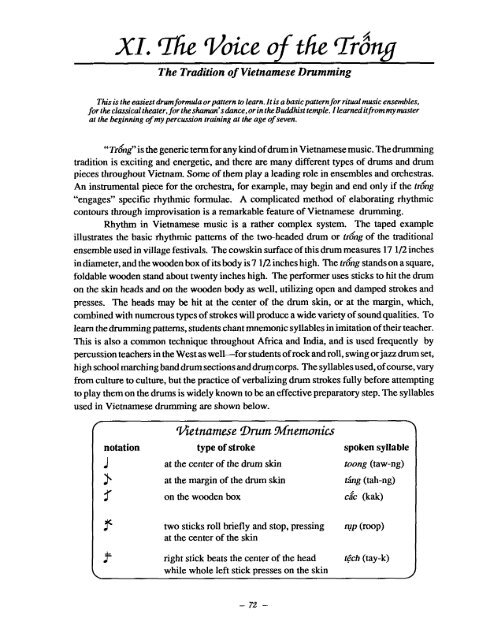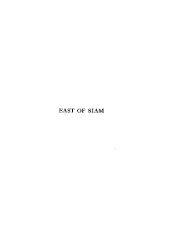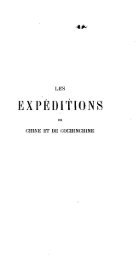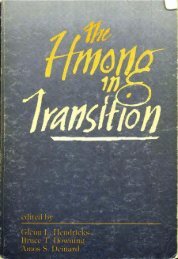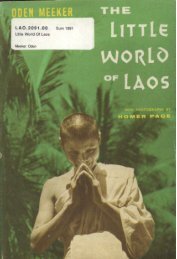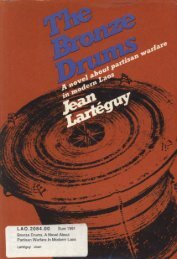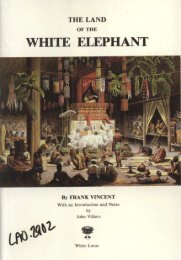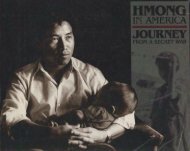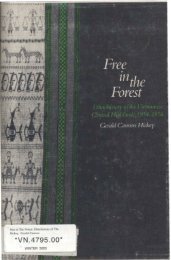and Temple Yards
iutnam From Rice Paddies and Temple Yards - Refugee Educators ...
iutnam From Rice Paddies and Temple Yards - Refugee Educators ...
- No tags were found...
Create successful ePaper yourself
Turn your PDF publications into a flip-book with our unique Google optimized e-Paper software.
XI. The Voice of the iring<br />
The Tradition of Vietnamese Drumming<br />
This is the easiest drum formula or pattern to learn. It is a basic pattern for rituul music ensembles,<br />
for the classical theater, for the shaman'sdance, or in the Buddhist temple. I learned it frommy master<br />
at the beginning of my percussion training at the age of seven.<br />
" ~r6nf is the generic term for any kind of drum in Vietnamese music. The drumming<br />
tradition is exciting <strong>and</strong> energetic, <strong>and</strong> there are many different types of drums <strong>and</strong> drum<br />
pieces throughout Vietnam. Some of them play a leading role in ensembles <strong>and</strong> orchestras.<br />
An instrumental piece for the orchestra, for example, may begin <strong>and</strong> end only if the t&ng<br />
"engages" specific rhythmic formulae. A complicated method of elaborating rhythmic<br />
contours through improvisation is a remarkable feature of Vietnamese drumming.<br />
Rhythm in Vietnamese music is a rather complex system. The taped example<br />
illustrates the basic rhythmic patterns of the two-headed drum or ding of the traditional<br />
ensemble used in village festivals. The cowskin surface of this drum measures 17 112 inches<br />
in diameter, <strong>and</strong> the wooden box of its body is 7 1/2 inches high. The &ng st<strong>and</strong>s on a square,<br />
foldable wooden st<strong>and</strong> about twenty inches high. The performer uses sticks to hit the drum<br />
on the skin heads <strong>and</strong> on the wooden body as well, utilizing open <strong>and</strong> damped strokes <strong>and</strong><br />
presses. The heads may be hit at the center of the drum skin, or at the margin, which,<br />
combined with numerous types of strokes will produce a wide variety of soundqualities. To<br />
learn the drumming patterns, students chant mnemonic syllables in imitation of their teacher.<br />
This is also a common technique throughout Africa <strong>and</strong> India, <strong>and</strong> is used frequently by<br />
percussion teachers in the West as well-for students of rock <strong>and</strong> roll, swing or jazz drum set,<br />
high school marching b<strong>and</strong> drum sections <strong>and</strong> drum corps. The syllables used, of course, vary<br />
from culture to culture, but the practice of verbalizing drum strokes fully before attempting<br />
to play them on the drums is widely known to be an effective preparatory step. The syllables<br />
used in Vietnamese drumming are shown below.<br />
Vktmme Drum Mnemonics 3<br />
notation type of stroke spoken syllable<br />
J at the center of the drum skin toong (taw-ng)<br />
31 at the margin of the drum skin thg (tah-ng)<br />
f on the wooden box ca"c (kak)<br />
? two sticks roll briefly <strong>and</strong> stop, pressing ryp (roop)<br />
at the center of the skin<br />
f- right stick beats the center of the head t&h (tay-k)<br />
while whole left stick presses on the skin<br />
J


